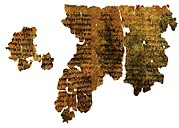
Back מיסטיקה יהודית HE Kabala i mistika Croatian Misticismo ebraico Italian Jødisk mystisisme NB Misticismo judaico Portuguese
| Jewish mysticism |
|---|
 |
| History of Jewish mysticism |
Academic study of Jewish mysticism, especially since Gershom Scholem's Major Trends in Jewish Mysticism (1941), draws distinctions between different forms of mysticism which were practiced in different eras of Jewish history. Of these, Kabbalah, which emerged in 12th-century southwestern Europe, is the most well known, but it is not the only typological form, nor was it the first form which emerged. Among the previous forms were Merkabah mysticism (c. 100 BCE – 1000 CE), and Ashkenazi Hasidim (early 13th century) around the time of the emergence of Kabbalah.
Kabbalah means "received tradition", a term which was previously used in other Judaic contexts, but the Medieval Kabbalists adopted it as a term for their own doctrine in order to express the belief that they were not innovating, but were merely revealing the ancient hidden esoteric tradition of the Torah. This issue has been crystalized until today by alternative views on the origin of the Zohar, the main text of Kabbalah, attributed to the circle of its central protagonist Rabbi Shimon Bar Yochai in the 2nd century CE, for opening up the study of Jewish Mysticism.[1] Traditional Kabbalists regard it as originating in Tannaic times, redacting the Oral Torah, so do not make a sharp distinction between Kabbalah and early Rabbinic Jewish mysticism. Academic scholars regard it as a synthesis from the Middle Ages, when it appeared between the 13th-15th centuries, but assimilating and incorporating into itself earlier forms of Jewish mysticism, possible continuations of ancient esoteric traditions,[2] as well as medieval philosophical elements.
The theosophical aspect of Kabbalah itself developed through two historical forms: "Medieval/Classic/Zoharic Kabbalah" (c.1175 – 1492 – 1570), and Lurianic Kabbalah (1569 – today) which assimilated Medieval Kabbalah into its wider system and became the basis for modern Jewish Kabbalah. After Luria, two new mystical forms popularised Kabbalah in Judaism: antinomian-heretical Sabbatean movements (1666 – 18th century), and Hasidic Judaism (1734 – today). In contemporary Judaism, the only main forms of Jewish mysticism which are practiced are esoteric Lurianic Kabbalah and its later commentaries, the variety of schools of Hasidic Judaism, and Neo-Hasidism (incorporating Neo-Kabbalah) in non-Orthodox Jewish denominations.
Two non-Jewish syncretic traditions also popularized Judaic Kabbalah through their incorporation as part of general Western esoteric culture from the Renaissance onwards: theological Christian Cabala (c. 15th – 18th century) which adapted Judaic Kabbalistic doctrine to Christian belief, and its diverging occultist offshoot Hermetic Qabalah (c. 19th century – today) which became a main element in esoteric and magical societies and teachings. As separate traditions of development outside Judaism, drawing from, syncretically adapting, and different in nature and aims from Judaic mysticism, they are not listed on this page.
- ^ "Jewish Mysticism (Explained)". judaismtimes.com. Retrieved 20 August 2022.
- ^ In Major Trends in Jewish Mysticism (1941), Gershom Scholem rejected the possibility of original ancient source texts for the Zohar. In Kabbalah: New Perspectives (1990), Moshe Idel reassessed this, seeing implicit continuity between options in ancient jewish mystical ideas (including orthodox Rabbinic and heterodox Jewish Gnostic), and the medieval emergence of Kabbalah